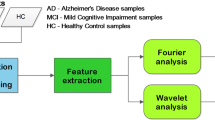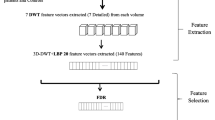Abstract
Diagnosis of Alzheimer’s disease (AD), mild cognitive impairment (MCI), and healthy subjects (Healthy) is currently lacking an automated tool. It requires experience of neuropsychologists and has sensibilities of 80% when separating between Healthy and MCI. The aim of this work is to evaluate the performance of a method for classification among the three groups using a database of 17 Healthy, 9 MCI and 15 AD. The method uses wavelet decomposition of the EEG signal (Haar mother wavelet and 5 decomposition levels) to calculate the wavelet entropy and theta and beta relative power of the EEG signal. These features are used as inputs to a three-way classifier consisting in a support vector machine with polynomial kernel and a two-layer neural network. The last implements a vote procedure. Wavelet entropy was evaluated together with the sample entropy and approximated entropy to choose the one that best detected changes in the complexity of the EEG signal. The results show that it is possible to automatically classify a subject of a particular group with an overall accuracy of 92.6%, close to the best result found in the literature that is 97.9%. The method could be the basis for the implementation of a diagnosis-support quantitative tool oriented to aid in clinical diagnosis, especially when the classification between the three groups is not one of the more represented researches in the consulted literature.






Similar content being viewed by others
References
Alzheimer’s A (2017) 2017 Alzheimer’s disease facts and figures. Alzheimer’s Dement 13(4):325–373
A. s. Society (2019) What is Alzheimer’s disease. https://www.alzheimers.org.uk/about-dementia/types-dementia/alzheimers-disease
Ocaña Montoya CM, Montoya Pedrón A, Bolaño Díaz GA (2019) Perfil clínico neuropsicológico del deterioro cognitivo subtipo posible Alzheimer. MEDISAN 23(5):875–891
Alzheimer’s A (2019) 2019 Alzheimer’s disease facts and figures. Alzheimer’s Dement 15(3):321–387
Wang R, Wang J, Li S, Yu H, Deng B, Wei X (2015) Multiple feature extraction and classification of electroencephalograph signal for Alzheimers’ with spectrum and bispectrum. Chaos Interdiscip J Nonlinear Sci 25(1):013110
Mittal SH (2016) Abnormal levels of consciousness and their electroencephalogram correlation: a review. EC Neurol Rev Article 4(1):30–35
Ya M, Xun W, Wei L, Ting H, Hong Y, Yuan Z (2015) Is the electroencephalogram power spectrum valuable for diagnosis of the elderly with cognitive impairment? Int J Gerontol 9(4):196–200
Cassani R, Estarellas M, San-Martin R, Fraga FJ, Falk TH (2018) Systematic review on resting-state EEG for Alzheimer’s disease diagnosis and progression assessment. Dis Mark 2018:26
Houmani N et al (2018) Diagnosis of Alzheimer’s disease with electroencephalography in a differential framework. PLoS ONE 13(3):e0193607
Musaeus CS et al (2018) EEG theta power is an early marker of cognitive decline in dementia due to Alzheimer’s disease. J Alzheimers Dis 64(4):1359–1371
Niedermeyer E, da Silva FL (2005) Electroencephalography: basic principles, clinical applications, and related fields. Lippincott Williams & Wilkins, Philadelphia
Al-Jumeily D, Iram S, Vialatte F-B, Fergus P, Hussain A (2015) A novel method of early diagnosis of Alzheimer’s disease based on EEG signals. Sci World J, vol 2015, no Special Issue
Dauwels J (2011) Slowing and loss of complexity in Alzheimer’s EEG: two sides of the same coin? Int J Alzheimer’s Dis 2011:539621
McBride JC et al (2015) Sugihara causality analysis of scalp EEG for detection of early Alzheimer’s disease. NeuroImage Clin 7:258–265
Dauwels J, Vialatte F-B, Cichocki A (2011) On the early diagnosis of Alzheimer’s disease from EEG signals: a mini-review. In: Wang R (ed) Advances in cognitive neurodynamics (II). Springer, Berlin, pp 709–716
Abásolo D, Hornero R, Espino P, Alvarez D, Poza J (2006) Entropy analysis of the EEG background activity in Alzheimer’s disease patients. Physiol Meas 27(3):241
Hornero R, Abásolo D, Escudero J, Gómez C (2009) Nonlinear analysis of electroencephalogram and magnetoencephalogram recordings in patients with Alzheimer’s disease. Philos Trans R Soc Math Phys Eng Sci 367(1887):317–336
Coronel C et al (2017) Quantitative EEG markers of entropy and auto mutual information in relation to MMSE scores of probable Alzheimer’s disease patients. Entropy 19(3):130
Al-nuaimi AH, Jammeh E, Sun L, Ifeachor E (2015) Tsallis entropy as a biomarker for detection of Alzheimer’s disease. Presented at the 2015 37th annual international conference of the IEEE engineering in medicine and biology society (EMBC), 2015. https://ieeexplore.ieee.org/abstract/document/7319312
Morabito FC, Labate D, La Foresta F, Bramanti A, Morabito G, Palamara I (2012) Multivariate multi-scale permutation entropy for complexity analysis of Alzheimer’s disease EEG. Entropy 14(7):1186–1202
Zhang D (2019) Wavelet transform. In: Zhang D (ed) Fundamentals of image data mining. Texts in computer science. Springer, Berlin, pp 35–44
Rosso OA et al (2001) Wavelet entropy: a new tool for analysis of short duration brain electrical signals. J Neurosci Methods 105(1):65–75
Al-Qazzaz NK, Hamid Bin Mohd Ali S, Ahmad SA, Islam MS, Escudero J (2015) Selection of mother wavelet functions for multi-channel EEG signal analysis during a working memory task. Sensors 15(11):29015–29035
Tatum W IV, Hausain A, Banbadis S, Kaplan P (2008) Handbook of EEG interpretation. Demos Medical Publishing, LLC, New York City
Abásolo D, Hornero R, Espino P, Poza J, Sánchez CI, de la Rosa R (2005) Analysis of regularity in the EEG background activity of Alzheimer’s disease patients with approximate entropy. Clin Neurophysiol 116(8):1826–1834
Sleigh JW, Olofsen E, Dahan A, De Goede J, Steyn-Ross DA (2001) Entropies of the EEG: the effects of general anaesthesia. In: Paper presented at the 5th international conference on memory, awareness and consciousness, 1-3 June 2001, New York
Zanin M, Zunino L, Rosso OA, Papo D (2012) Permutation entropy and its main biomedical and econophysics applications: a review. Entropy 14(8):1553–1577
James G (1998) Majority vote classifiers: theory and applications. In: Dissertation in partial fulfillment of the requirements for the degree of Doctor of Philosophy. Stanford University, Stanford, USA. Available in: http://faculty.marshall.usc.edu/gareth-james/Research/thesis.pdf
Ghorbanian P, Devilbiss DM, Hess T, Bernstein A, Simon AJ, Ashrafiuon H (2015) Exploration of EEG features of Alzheimer’s disease using continuous wavelet transform. Med Biol Eng Comput 53(9):843–855
Uyulan C, ERguzel TT (2016) Comparison of wavelet families for mental task classification. J Neurobehav Sci. https://doi.org/10.5455/JNBS.1454666348
Alomari MH, Awada EA, Samaha A, Alkamha K (2014) Wavelet-based feature extraction for the analysis of EEG signals associated with imagined fists and feet movements. Comput Inf Sci 7(2):17
Jeong D-H, Kim Y-D, Song I-U, Chung Y-A, Jeong J (2016) Wavelet energy and wavelet coherence as EEG biomarkers for the diagnosis of Parkinson’s disease-related dementia and Alzheimer’s disease. Entropy 18(1):8
Castillo AJS (2012) Castillo, Apuntes de Estadística para Ingenieros. Creative Commons, Jaén
Fernández A, Gregorio PG, Maestú F (2012) Actividad espontánea electroencefalográfica y magnetoencefalográfica como marcador de la enfermedad de Alzheimer y el deterioro cognitivo leve. Revista Española de Geriatría y Gerontología 47(1):27–32
Simons S, Espino P, Abásolo D (2018) Fuzzy entropy analysis of the electroencephalogram in patients with Alzheimer’s disease: is the method superior to sample entropy? Entropy 20(1):21
Allan CL, Behrman S, Ebmeier KP, Valkanova V (2017) Diagnosing early cognitive decline: when, how and for whom? Maturitas 96:103–108
Charernboon T (2017) Diagnostic accuracy of the overlapping infinity loops, wire cube, and clock drawing tests for cognitive impairment in mild cognitive impairment and dementia. Int J Alzheimer’s Dis 2017:5289239. https://doi.org/10.1155/2017/5289239
Acknowledgements
Funding was provided by VLIR.
Author information
Authors and Affiliations
Corresponding author
Additional information
Publisher's Note
Springer Nature remains neutral with regard to jurisdictional claims in published maps and institutional affiliations.
Rights and permissions
About this article
Cite this article
Santos Toural, J.E., Montoya Pedrón, A. & Marañón Reyes, E.J. Classification among healthy, mild cognitive impairment and Alzheimer’s disease subjects based on wavelet entropy and relative beta and theta power. Pattern Anal Applic 24, 413–422 (2021). https://doi.org/10.1007/s10044-020-00910-8
Received:
Accepted:
Published:
Issue Date:
DOI: https://doi.org/10.1007/s10044-020-00910-8




